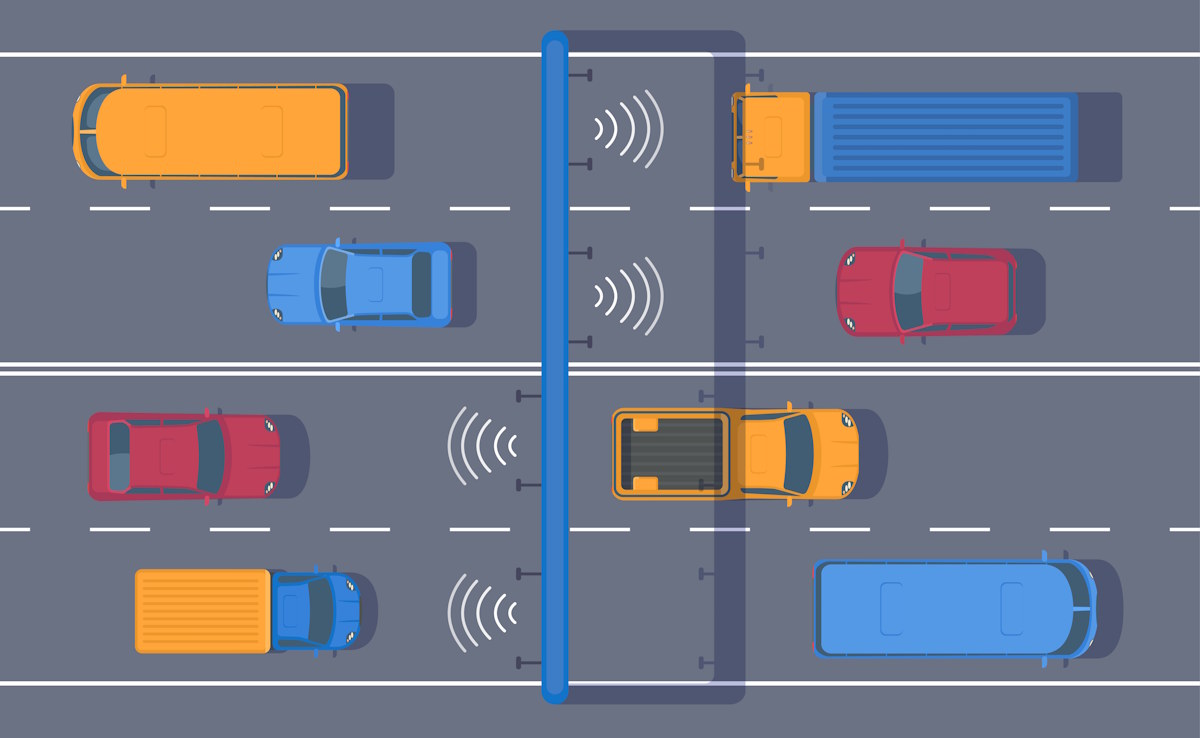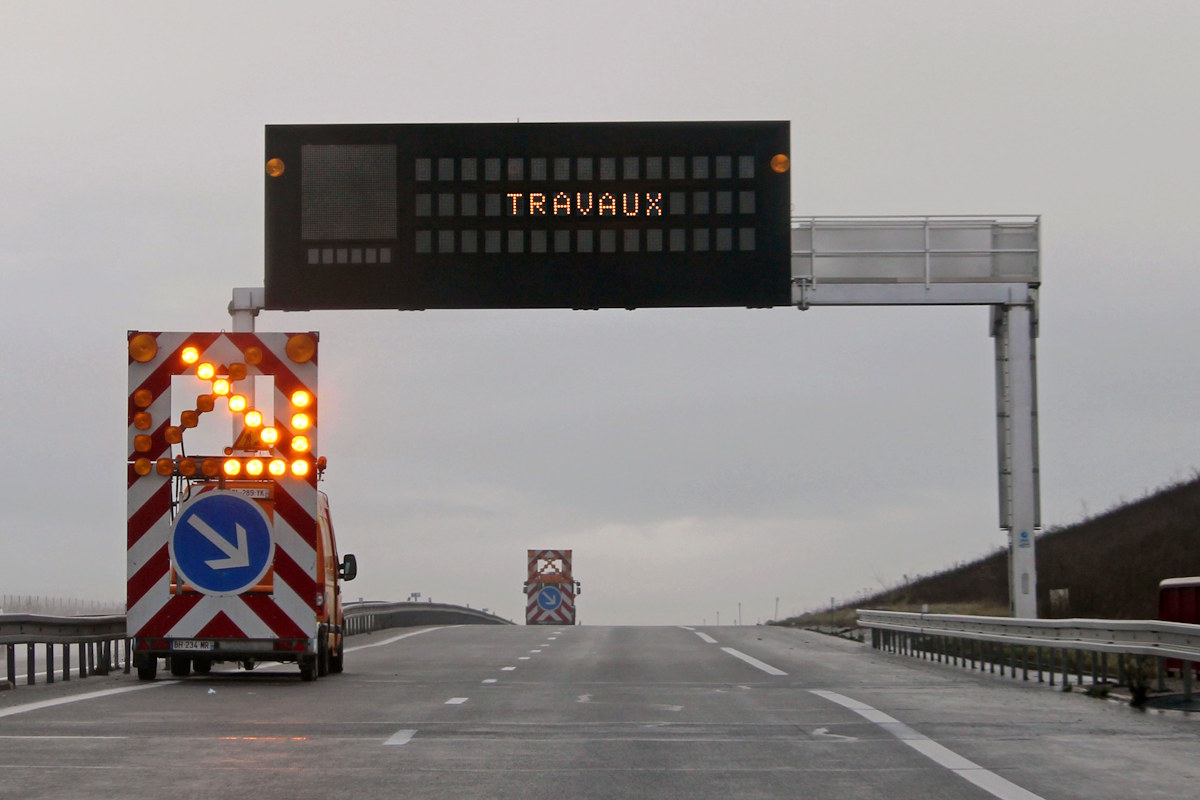By Florian König, maut1.de - 24 April 2025
Imagine you could drive past toll stations without stopping and continue your journey without a traffic jam. More and more countries are turning to free-flow systems, which not only improve traffic flow, but also offer a variety of benefits for drivers and the environment.
In this blog article, you can find out how automatic toll collection via free-flow systems on motorways not only increases infrastructure efficiency, but also helps to save costs and reduce emissions.
Long-standing toll practice: toll stations for collecting and paying tolls
A toll station is a so-called "stationary facility for collecting a user fee" (= toll) for motorways and other toll roads.
The toll station itself consists of one or more control buildings equipped with a barrier. At these, the toll is either collected immediately on site (e.g. tunnels, bridges or mountain passes) or a ticket is first purchased from a machine, which is used to calculate a distance-based fee when leaving the toll road (e.g. on motorways in Italy or France). At larger motorway junctions, you usually have to pay for the distance travelled up to that point and buy a new ticket for the next section of the route.
One of the main disadvantages of collecting tolls using toll stations compared to a completely electronic free-flow system is the slowdown in traffic flow at the toll stations, which can lead to traffic jams. Especially at peak travel times during the holidays and summer months, slowing down in front of the toll stations leads to a chain reaction due to the effect of "phantom congestion".
In addition, there is the financial outlay for the costs of setting up and maintaining the toll stations and staffing them with sufficient personnel.

Fully automatic toll collection through Free Flow with licence plate recognition
Instead of permanently installed toll stations, which slow down the flow of traffic, the so-called "free-flow system" has been in place for some time now.
The free-flow system (literally: "free flow") enables the toll to be collected automatically while vehicles pass through a toll zone without delay. There are no longer any physical toll stations: instead, cameras and sensors on a toll bridge record the licence plate number or communicate directly with special on-board units (toll boxes in the car).
Payment of tolls in the free flow system can or must be made within 15 days (in Italy) or within 72 hours! (in France) after the journey in order to Penalties for unpaid tolls avoid.
When paying on site, e.g. at the next rest area behind the toll bridge, you first have to enter your licence plate number at the payment terminals to find out what costs have been incurred for your own vehicle. Payment can then be made in cash or by credit card.
It is somewhat easier to pay the respective toll charges online. The operators of motorways with free flow systems such as Sanef, Aliae or the Autostrada Pedemontana offer various payment options after registration on their websites. In this case too, you must first search for your own vehicle registration number and then pay the corresponding toll amount by debit or credit card.
The easiest way to pay the free-flow tolls incurred is in combination with a toll box from maut1.de. By linking the vehicle's licence plate number to the bank account or credit card, the toll charges incurred are automatically debited.
This also avoids the risk of a penalty if you fail to pay the toll within the payment deadline, which can quickly amount to several hundred euros!

In which countries is Free Flow already being used
Italy traditionally already has a dense network of toll stations. However, some motorway operators, such as Autostrada Pedemontana Lombarda in northern Italy, are already using Free Flow. Projects on the A4 and A15 motorways are also testing modern toll collection systems without barriers. In future, Italy is planning to introduce free-flow technology on other important routes, particularly around major cities such as Milan or Rome.
France is already further ahead with its "Flux Libre" (free flow) project. Particularly on new stretches such as the A79 motorway between Moulins and Montmarault, there are no longer any classic péages. Other stretches, such as parts of the A13 and A14 motorways in the greater Paris area, are to follow. Drivers are informed of the new system by large signs ("Péage sans arrêt" - toll without stopping).
What to look out for when travelling in countries with free-flow systems
- Register in good time: Before starting your journey, find out whether free-flow toll systems are already in use on the planned route and register your vehicle's licence plate number in advance if necessary.
- Payment deadlines: If you have not registered your licence plate number, make sure you make the toll payment(s) within the prescribed deadlines (15 days to 72 hours) to avoid unnecessary penalties.
- Use compatible toll boxes: If you already have an electronic toll box, check whether it can also be used for free flow in Italy and France, like the maut1.de toll box.
- Read the information signs: Motorway sections equipped with the modern free-flow system are clearly marked by signs with terms such as "Flux libre", "Péage sans arrêt" or "Free Flow".

The maut1.de toll box for all cars up to 3 metres high, cars with trailers and motorbikes.
Simply order online, unpack, stick it next to the interior mirror and start travelling stress-free in Italy, France, Spain and Portugal and save time at toll stations.
Further information under Toll box for vehicles up to 3 metres high
The Free Flow System contributes to environmental protection through reduced emissions
The Free Flow System contributes to environmental protection in various ways thanks to the modern combination of traffic telematics and tolling systems:
- Reducing stop-and-go traffic: The barrier-free toll system means that vehicles no longer have to stop, as the system automatically records the toll electronically while the vehicle is travelling. This results in significantly fewer braking and acceleration processes with lower fuel and power consumption, which in turn reduces CO₂ emissions and generates less particulate pollution from brake wear.
- Increased efficiency in traffic flow: By eliminating toll stations and the need to stop, traffic flows more smoothly overall without braking, which avoids traffic jams and also saves travellers travel time.
- Promoting sustainable mobility: The more accurate collection of traffic data allows traffic infrastructure to be planned and optimised in a more targeted manner, which enables smarter traffic management and the promotion of alternative modes of transport (e.g. public transport).
- Data-driven environmental planning: The data collected by automatic toll collection (e.g. traffic density, driving behaviour, etc.) can contribute to the analysis of emissions and the optimisation of environmental policy. For example, time-based environmental zones can be better designed or emission-intensive routes can be specifically improved.
- Less infrastructure requirements: Since physical toll stations with barriers at the start and end of toll sections will no longer be necessary in future, less construction material and less space will be used, which protects the environment and habitats.
Challenges and solutions when implementing free flow
Modern transport infrastructure is constantly evolving with free flow systems (also known as multi-lane free flow or MLFF), but these highly complex systems present numerous technical challenges. The following points need to be considered when installing free flow systems:
Vehicle detection and identification
The precise detection and identification of vehicles is one of the most fundamental requirements of free flow systems. A variety of technologies are used, such as cameras for automatic number plate recognition, DSRC (Dedicated Short-Range Communication), RFID (Radio-Frequency Identification) or GNSS (Global Navigation Satellite System).
The challenge is that these systems have to work reliably under a wide range of conditions: bad weather, night-time driving, high speeds or dirty number plates can significantly impair correct detection. In addition, a correct distinction must be made between different vehicle classes (e.g. cars vs. lorries) to ensure correct toll calculation
Lane-accurate detection at high speed
In a free-flow system, many vehicles drive simultaneously in several lanes next to each other without barriers and may change lanes directly under the toll bridge. However, highly efficient sensor, radar and image processing technologies are required to ensure that every vehicle, regardless of which lane it is in when passing through the toll checkpoint, is correctly recorded and later billed.
Data security and data protection
Data protection and data security must also be taken into account when collecting sensitive data such as location, vehicle number plates and movement profiles. For example, end-to-end encryption of the collected data must be guaranteed and all legal requirements, such as the GDPR in the EU, must be fulfilled. Finally, all data from the collection, processing and billing of tolls must also be protected against misuse or manipulation.
System integration and interoperability
The new free-flow systems must be able to integrate seamlessly into the existing toll systems, traffic management and billing systems despite different standards and existing "old" technologies in the various countries. Energy and network supply The establishment of a robust infrastructure with power and data connections, possibly with solar power or the use of 5G networks, is essential to ensure the operation of the systems, especially in more remote areas such as mountain routes.
Maintenance and calibration
To ensure continuous accuracy and efficiency of the systems, sensors, cameras and antennas must be maintained and calibrated at regular intervals, with maintenance carried out in a way that minimises disruption to ongoing traffic.

Future outlook: The development of free flow in Europe and worldwide
The future of toll collection is increasingly being shaped by innovative approaches such as free flow systems, which enable congestion-free "tolling". Many countries in Europe are recognising the benefits of these technologies, which not only improve traffic flow but also significantly reduce the time spent by all travellers
By eliminating the need for physical toll stations, the well-known traffic jams during the holiday season can be avoided, saving valuable travel time. The systems and the optimised traffic flow also reduce the environmental impact, as vehicles drive more evenly and produce fewer emissions.
We are certain that free-flow systems will play an increasingly important role in the transport infrastructure in Europe and worldwide in the coming years, benefiting both drivers and the environment.
& Free Flow Graphic @ Ilya_kovshik / adobe.stock.com & Construction site @ hugopm / adobe.stock.com

.webp?ts=1719437796)